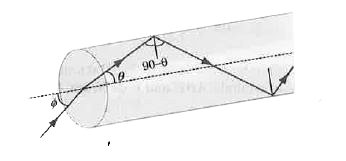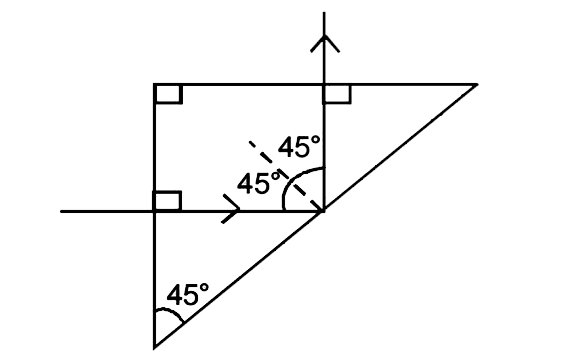Total internal reflection of light ray from cylindrical optical fiber
An optical fiber consists of a cylindrical core of unknown refractive index kept in air. A ray of light is incident on the flat face of the core so that it gets totally reflected at the curved surface (Fig.34-19). What is the possible refractive index if the ray is totally reflected at any angle of incidence ϕ from air ?
When a ray refracts from air to glass, total internal reflection cannot occur. However, when this ray strikes curved surface of the fiber, the incidence is from denser to rarer medium. If n is such that total internal reflection occurs at this point, it will continue to occur as the ray strikes the curved surface repetedly at the same angle.
Calculation : Let us assume that the ray is incident at an angle ϕ from air and is refracted into the cylinder at an angle θ. It is then again incident on the air cylinder boundary at the curved surface as shown in Fig. 34-19 . The condition is that the ray should undergo total internal reflection at the face.
For this the angle of incidence here should be greater than critical angle.
90∘−θ>θc
Since sine is an increasing function, taking sine of both sides will not change the inequality.
sin(90∘−θ)>sinθc=1n(nsinθc=1×sin90∘)
cosθ≥1n
Again, applying Snell.s law at flat face, we get
1×sinϕ=n×sinθ
Squaring and adding , we get
n2sin2θ+n2cos2θ≥1+sin2ϕ
n2≥1+sin2ϕ
But the maximum value of sinϕ is 1 when the angle of incidence is 90∘. For this condition,
n2≥2
or n≥√2
Learn : Interestingly this yields μ≥1.41. Thus, even ordinary glass can be used in optical fiber. But for practical reasons, this core is coated with a cylindrical shell called cladding. If cladding has refractive index of μ1, the condition on μ2 is
μ2≥√μ21+1

Topper's Solved these Questions
- GEOMETRICAL OPTICS : REFRACTIONBOOK - RESNICK AND HALLIDAYCHAPTER - GEOMETRICAL OPTICS : REFRACTIONEXERCISE - Check point
6 Videos
- GEOMETRICAL OPTICS : REFRACTIONBOOK - RESNICK AND HALLIDAYCHAPTER - GEOMETRICAL OPTICS : REFRACTIONEXERCISE - Problems
44 Videos
- GEOMETRICAL OPTICS : REFLECTION BOOK - RESNICK AND HALLIDAYCHAPTER - GEOMETRICAL OPTICS : REFLECTION EXERCISE - PRACTICE QUESTIONS (Integer Type)
3 Videos
- GRAVITATIONBOOK - RESNICK AND HALLIDAYCHAPTER - GRAVITATIONEXERCISE - PRACTICE QUESTIONS (INTEGER TYPE)
4 Videos
Similar Questions
At what angle should a ray of light be incident on the face of a prism of refracting angle 60∘, so that it just suffers total internal reflection at the other face ? The refractive index of the prism is 1.524.
View SolutionAt what angle should a ray of light be incident on the face of a prism of refracting angle 60∘ so that it just suffers total internal reflection at the other face ? The refractive index of the prism is 1.524.
View Solution
Knowledge Check
A ray of light is incident on the surface of a glass plate at an angle of incidence equal to Brewster's angle ϕ. If μ represents the refractive index of glass with respect to air, then the angle between reflected and refracted rays is
A(a) 90∘+ϕB(b) sin−1(μcosϕ)C(c) 90∘D(d) 90∘−sin−1(sinϕ/μ)
At what angle should a ray of light be incident on the face of a prism of refracting angle 60∘ so that it just suffers total internal reflection at the other face ? The refractive index of the prism is 1.524.
View SolutionAt what angle should a ray of light be incident on the face of a prism of refracting angle 60° so that it just suffers total internal reflection at the other face ? The refractive index of the material of the prism is 1.524.
View SolutionThe refractive index of the core of an optical fibre is μ2 and that of the cladding is μ1 .The angle of incidence on the face of the core so that the light ray just under goes total internal reflection at the cladding is
View SolutionThe refractive index of the core of an optical fibre is μ2 and that of the cladding is μ1. The angle of incidence on the face of the core of that the light ray just under goes total internal reflection at the cladding is
View SolutionA ray of light is incident on the surface of a glass plate at an angle of incidence equal to Brewster's angle ϕ. If μ represents the refractive index of glass with respect to air, then the angle between reflected and refracted rays is
View SolutionA ray of light is incident on the surface of a glass plate of reflective index 1.536 such that the reflected and refracted rays are mutually perpendicular. What is the angle of reflection ?
View SolutionA light ray is incident perpendicularly to one face of a 90∘ prism and is totally internally reflected at the glass-air interface. If the angle of reflection is 45∘, we conclude that the refractive index n

View Solution
